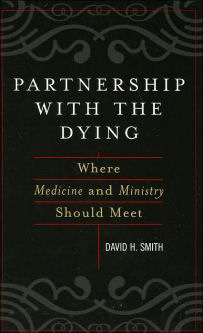
|
Posted August 30, 2005
Book: Partnership with the Dying: Where Medicine and Ministry Should Meet Author: David H. Smith Rowman & Littlefield Publishers, Lanham, MD, pp. 135 An Excerpt from the Jacket:
An Excerpt from the Book: Rituals A final dimension of religious initiative should be attention to ritual. Community and ritual are intrinsically yoked concepts. Whatever the ritual be --- those of reading from scripture, liturgical drama, or the confession of sins – religious communities grasp that they are central to their communities’ health. It’s hard to sustain a vital religious community if worship is boring, unintelligible, or vapid. Good ritual has at least two characteristics: it is meaningful, and to some degree it is habitual. Ritual is precisely not something that one continuously improves. It has constant elements; it has a certain degree of predictability; it is reliable. Anyone who is at all attuned to religion should appreciate the importance of ritual. We often depict these characteristics of ritual in a critical vein. W say that some political or economic statement or act was “just pure ritual,” by which we mean inauthentic or insincere. In fact families, workplaces, and educational institutions are sustained by rituals: of athletic contests or eating together, of staff meetings, lunch conversations, and daily greetings; of matriculation, graduation, and special recognition. At its best, ritual is a social habit that marks important transitions in our lives and loves. Ritual helps us get through difficult points; it relates to routine and habit --- essential aspects of life that we too often take for granted. Groups that are involved in care for the dying need ritual debriefings, moments of silence, and confessions as part of their professional routine. These rituals need not be religious in any traditional sense; they should simply help to sustain the diverse pieties of persons trying to cope with recurrent and intense encounters with death. The expectation of these ritual moments is essential to sanity; their provision should be habitual. Good ritual requires more than regularity; it requires some allocation of space and time. Consider the remarks of a nurse describing some of her conflicts over end-of-life care: “Sometimes I was angry about the whole issues of physicians not being honest with their patients. That was really hard for me to deal with. And, you know, them saying, “You can’t talk to her about dying, because I haven’t had the discussion with her yet.” Well, when are you going to have the discussion then? It’s time to do it. And that was hard. Not that it was scary. It just made me mad. I don’t think I was ever so scared, once I got past that first patient who died. I had one situation where the physician was treating the patient very aggressively. And I thought it was time to back off. And we actually went into a conference room, and we had a fight. I mean, a yelling fight about what was ethical and not ethical, and why was he doing this? And if this was for his research, that was not a good enough reason. And we went round and round and round about that. But he was the rare physician who was willing to go into a conference room with you and do that. Not that I got my way in the end, because I didn’t. But he listened. Most of them, you can’t get that much of their time. You know, they don’t want to talk about it. They’re busy.” Translating this statement into my jargon, this nurse is suggesting that space and time need to be carved out for these conversations. They should not occur in the corridor, as many of them do; they should not be completely ad hoc, as she suggests they usually are. They are integral parts of the life of the caregiving community, and resources of space and time must be committed to make them possible. Providing resources for the humane side of care for the dying, for regular conversations about things that matter desperately, is something that matters as much as provision of adequate technological resources. Table of Contents: Introduction and method Conversation partners Explaining and justifying Deciding for death Community and compromise Conclusion |
|
